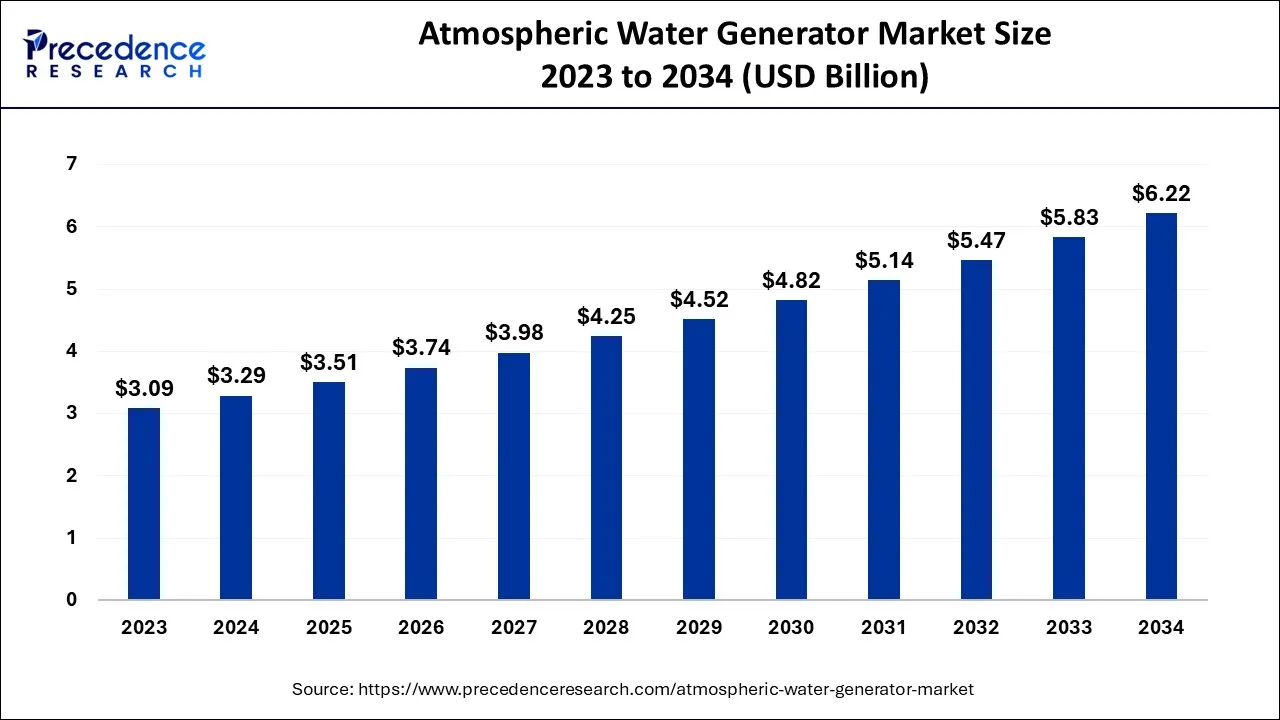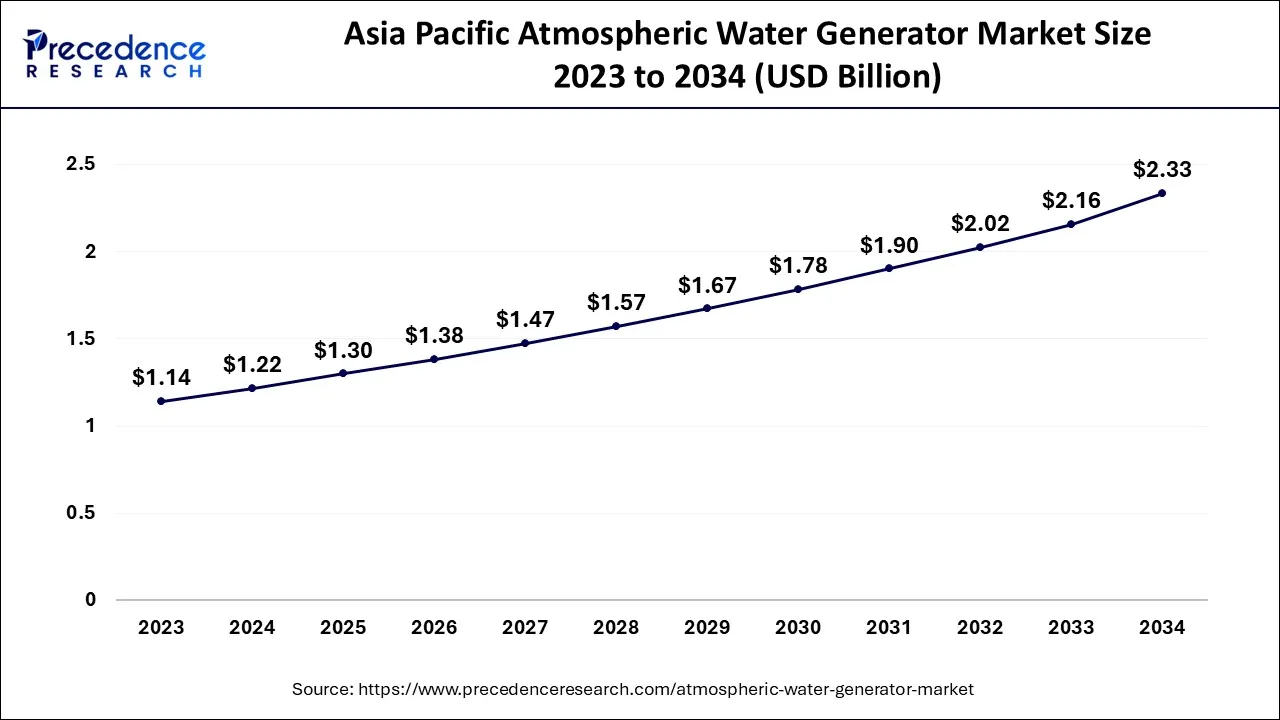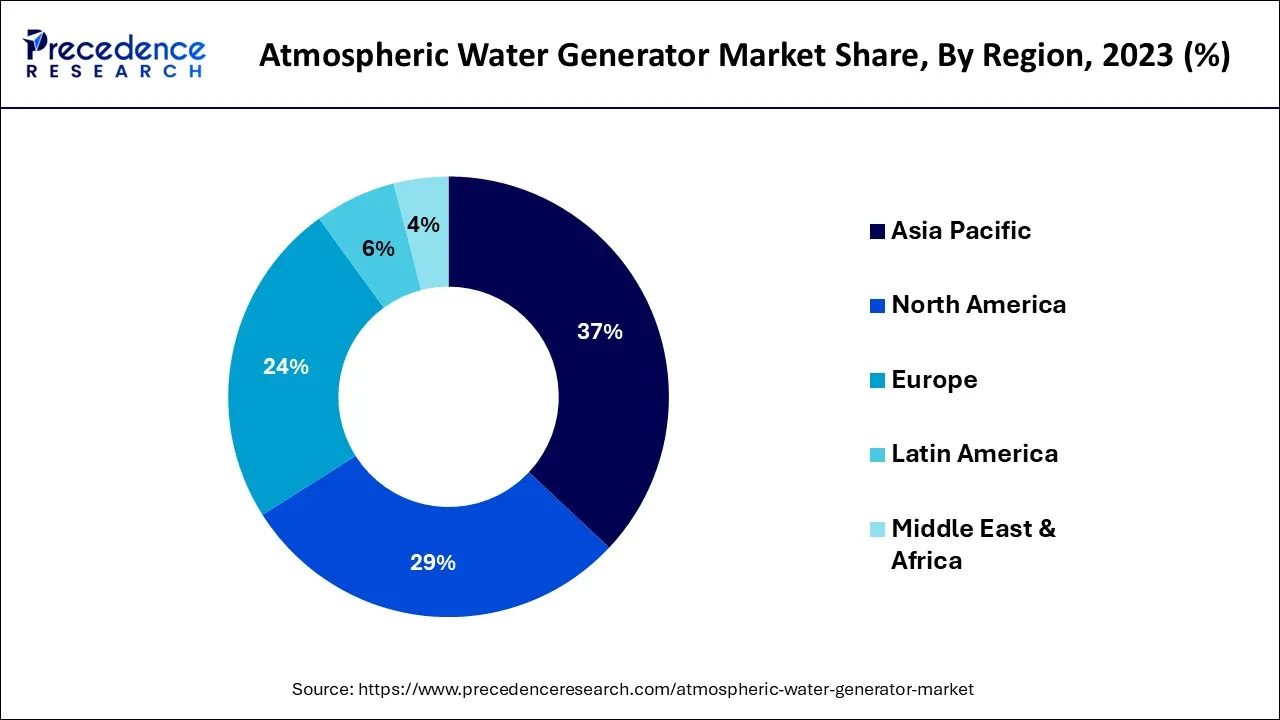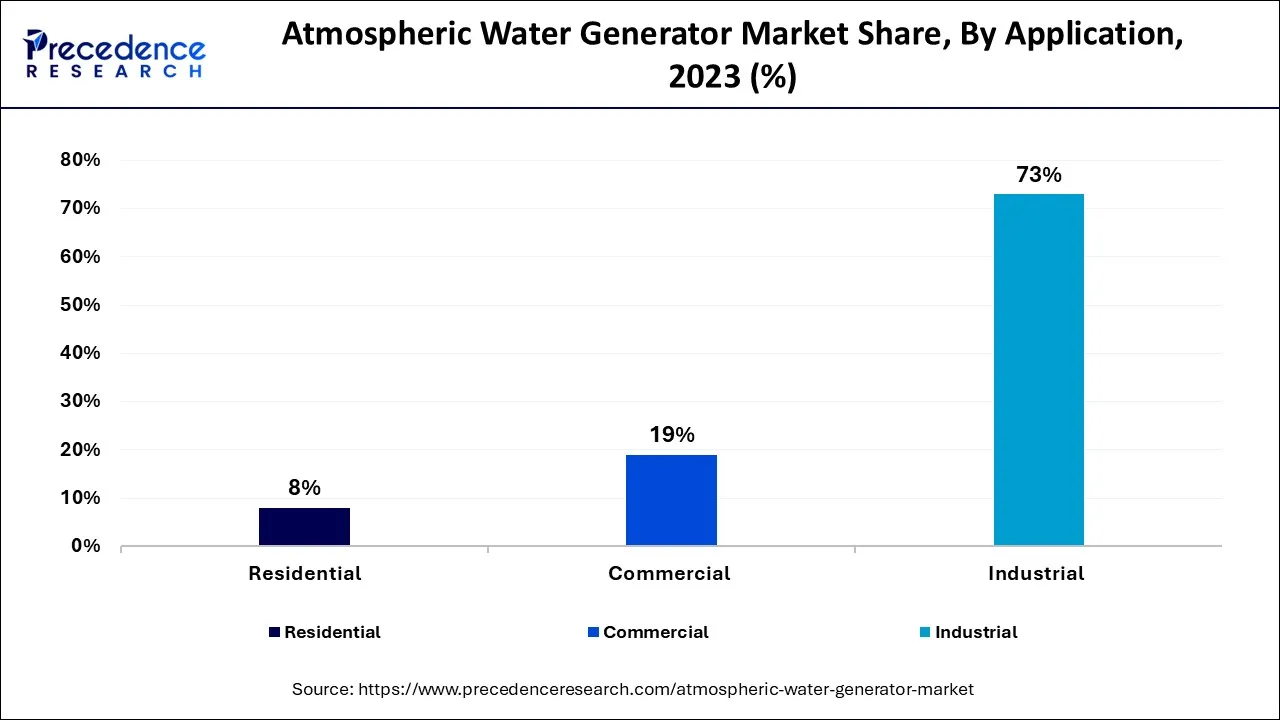January 2025
The global atmospheric water generator market size accounted for USD 3.29 billion in 2024, grew to USD 3.51 billion in 2025, and is expected to be worth around USD 6.22 billion by 2034, poised to grow at a CAGR of 6.58% between 2024 and 2034. The Asia Pacific atmospheric water generator market size is predicted to increase from USD 1.22 billion in 2024 and is estimated to grow at the fastest CAGR of 6.72% during the forecast year.
The global atmospheric water generator market size is expected to be valued at USD 3.29 billion in 2024 and is anticipated to reach around USD 6.22 billion by 2034, expanding at a CAGR of 6.58% over the forecast period from 2024 to 2034. Growing water pollution and rising scarcity of fresh drinking water are major factors to drive the market’s growth during the forecast period.

The Asia Pacific atmospheric water generator market size is exhibited at USD 1.22 billion in 2024 and is projected to be worth around USD 2.33 billion by 2034, growing at a CAGR of 6.72% from 2024 to 2034.

Asia Pacific captured for 36.4% of the global revenue share in the atmospheric water generator market. The rising concerns about drinking water scarcity are the leading factor in boosting the market’s growth in the region. The presence of significant players in China and India is supplementing the revenue share for the region. The rising cases of diseases associated with contaminated water in underdeveloped countries will offer lucrative demand for the installation of atmospheric water generators in Asia Pacific during the forecast period.

North America is projected to grow at a CAGR of 8.5% during the forecast period. The advancements in water generation technology are the major factor driving the market’s growth in the region. Rapid industrialization and the presence of major companies in the United States are leading factors to fuel the atmospheric water generator market growth in North America. Europe is another fastest-growing marketplace for atmospheric water generators owing to the rising focus on the development of advanced solutions to address global warming. The growth of the atmospheric water generator market in Europe is attributed to the presence of pollutants in the underground water.
The depletion of fresh water supplies in Latin America and the Middle East is considered to boost the development of atmospheric water generation technology. Several governments are encouraging water generation from the air; this factor is propelling the market’s growth. In a world where atmospheric water generation technology is not uncommon, economically weaker African countries are yet to catch the technology to resolve their water scarcity problem.
The atmospheric water generator produces drinkable, fresh, and clean water through the condensation of vapors in the air. In recent years, technological advancements in water generation technology have brought a cost-effective, efficient, and sustainable solution for the concerns related to water scarcity in the form of atmospheric water generators.
The atmospheric water generator uses thermodynamics, mechanical cycles, and an electronic control system to produce adequate water. The basic structure of an atmospheric water generator consists of a purifier, water filter, compressor, water condenser, air filter, carbon filter, and water tank.
The invention of advanced generators for various industries has been the center of attention for major market players. New product launches with the deployed smart system are boosting the growth of the global atmospheric water generator market.
The global atmospheric water generator market is expected to grow at a CAGR of 9% during the forecast period. Rising awareness for quality drinking water across the globe is one of the major factors boosting the global atmospheric water generator market growth. Creative ideas, public support and rising government financing for designing and developing advanced atmospheric water generators are promoting the market’s growth.
However, the high installation cost of atmospheric water generators is hindering the market's growth. The scarcity of fresh drinking water is another major factor boosting the market’s growth during the forecast period. According to UNICEF, almost two-thirds of the world’s population faces water shortages for at least one month each year.
The rising concerns related to freshwater scarcity will boost the demand for atmospheric water generators across the globe. Moreover, strategic business activities, including partnerships, mergers, and acquisitions by major companies, are supplementing the market’s growth.
| Report Coverage | Details |
| Market Size in 2024 | USD 3.29 Billion |
| Market Size by 2034 | USD 6.22 Billion |
| Growth Rate from 2024 to 2034 | CAGR of 6.58% |
| Largest Market | Asia Pacific |
| Fastest Growing Market | Europe |
| Base Year | 2023 |
| Forecast Period | 2024 to 2034 |
| Segments Covered | By Product, By Capacity and By Application |
| Regions Covered | North America, Europe, Asia-Pacific, Latin America and Middle East & Africa |
Rising government initiatives for producing safe drinking water
Underground water or even bottled water can affect human health with the presence of multiple microorganisms. Some microorganisms, including viruses and protozoa, can result in serious diseases, including hepatitis, diarrhea, and cholera. The rising health concerns have increased the demand for safe and clean drinking water.
Governments across the globe are focused on enhancing the standards for water treatment. Along with this, governments are continuing the implementation of various initiatives by which they can offer safe and clean drinking water in order to reduce the risks of diseases. Atmospheric water generators hold the potential to produce clean and purified water for drinking.
Considering the rising public health concerns, the demand for atmospheric water generators will increase from the government and private sector during the forecast period. Several European governments are focused on developing an alternative to expensive packaged bottled water; this will bring a plethora of opportunities for key players to expand their businesses in European countries.
High electricity consumption
The effective operation of atmospheric water generators requires a continuous energy supply. The high energy consumption, however, hampers the growth of the global market by limiting the purchasing capacity of small-scale industries. Moreover, the majority of environmental concerns are directly associated with high energy consumption. However, the development of energy-efficient atmospheric water generators is observed as a potential solution to this restraining factor.
Deployment of smart technologies in the atmospheric water generators
Manufacturers in the global atmospheric water generator market are focused on technological generator advancements. The deployment of smart technologies in the generators can be helpful for users to manage the operations with accurate monitoring without human intervention. The deployed smart technology, such as IoT, holds the potential to collect data associated with the generator on a routine basis.
The deployment of the Internet of Things (IoT) or artificial intelligence (AI) in the atmospheric water generator is observed to enhance productivity with ease for the users; subsequently, this will grow the demand for atmospheric water generators in the global market.
The cooling desiccation segment holds almost 99% of the share in the global atmospheric water generator market. Governments across the globe are focused on providing safe and clean drinking water in order to reduce the cases of diseases associated with contaminated water. Cooling desiccation allows the purification or filtration of water produced from the humidity or vapors. The rising requirement for clean water has increased the importance of cooling desiccation systems.
The wet desiccation segment is expected to grow at a CAGR of 7.8% during the forecast period. Wet desiccation is primarily used in manufacturing plants for water treatment, the rising installation of water generators in industrial areas will boost the growth of the wet desiccation segment during the forecast period. The wet desiccation technology deploys concentrated brine solution, which is a salt-based solution. The risk of corrosion in the atmospheric water generator hampers the development of a wet desiccation segment.
The more than 1000 liters water capacity segment holds the dominant share of the global atmospheric water generator market. Commercial places have a massive demand for atmospheric water generators; these generators can produce more than 1000 liters of fresh water daily. Manufacturers involved in the market are focused on designing and developing atmospheric water generators that produce fresh water of up to five thousand liters daily. At the same time, a home-based structure requires a compact atmospheric water generator which is expected to produce up to 50-60 liters per day. The rising installation of atmospheric water generators in residential areas will boost the growth of up to 60 liters of water capacity segment during the forecast period.
The industrial segment accounts for over 73% of the revenue share in the global atmospheric water generator market. The growing food and beverage industry across the globe has an enormous demand for freshwater supplies; this factor is fueling the growth of the industrial segment. Moreover, rising industrialization has a massive requirement for water supply. Manufacturing industries require water supply during the production process for diluting, fabricating, washing, and cooling purposes.

Water acts as a primary raw material in various industries, including the medical, electronics and food industries. Considering the rising demand for water supply from manufacturing industries, the installation of atmospheric water generators at manufacturing plants will grow during the forecast period.
The commercial segment is expected to grow at a CAGR of 8.7% during the forecast period due to the rising installation of atmospheric water generators in malls, schools, institutions, and other commercial structures in order to offer cost-effective fresh drinking water. The residential application segment in the global atmospheric water generator market holds a significant share. Changing lifestyles and growing awareness about clean drinking water are paramount factors to boost the demand for the installation of atmospheric water generators in residential societies or areas.
By Product
By Capacity
By Application
By Geography
For inquiries regarding discounts, bulk purchases, or customization requests, please contact us at sales@precedenceresearch.com
No cookie-cutter, only authentic analysis – take the 1st step to become a Precedence Research client
January 2025
November 2024
September 2024
January 2024